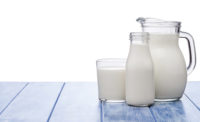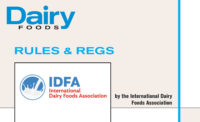Kevin Watts of Laubscher Cheese Co., Mercer, Pa., knew there had to be a better and faster way of labeling the company’s different products. The production line was weighing and labeling each block of cheese manually. Watts looked into automating the weighing and labeling to improve production speeds.
The cheesemaker isn’t alone. Labels and labeling equipment are on the minds of dairy processors and other manufacturers. A 2012 study by the Packaging Machinery Manufacturers Institute, a trade group based in Reston, Va., found that 59% of manufacturers will need new labeling equipment (or need to modify current equipment) to meet the changing needs of labeling, marking and coding.
As the study points out, “labels not only reflect the product manufacturer’s brand, they differentiate product packaging and provide consumers with an abundance of information about the product itself.”
PMMI’s research into labeling needs found these “key issues” confronting processors in the next three to five years:
- Reducing label unit costs
- Use of thinner label stock
- Reduction of label material waste
- Greater use of sustainable materials
- Implementing anti-counterfeiting and tamper-evident measures
- Improved tracking across the supply chain
Packagers are also looking at environmentally friendly options, the PMMI study found. Some of the new materials being tested include soy-based film, tree-free and paper-free stocks made from stone, and post-consumer recycled materials. PMMI reports that 13% of manufacturers are “actively moving away from the use of petroleum-based materials.”
Eco-friendly materials
Processors seek speed,ease of use |
|
According to PMMI’s “Trends in labeling 2012” report, product manufacturers seek the following from labeling machinery:
Source: Packaging Machinery Manufacturers Institute, Reston, Va. |
Prinkpack, Atlanta, is one labeling supplier helping its clients convert to more eco-friendly materials. “Printpack supports the conversion of less sustainable packaging materials to flexible,” said Lisa M. Preston, the company’s marketing communications manager.
She told Dairy Foodsthat Printpack is working with industry and customers to explore alternative materials and construction of existing flexible applications with these attributes: source reduction, renewable/bio-based content, additives which promote enhanced degradability, FDA-approved post-consumer resins for recycled content and alternative end-of-life scenarios for materials for which there is a limited recovery and recycling infrastructure.
Last year, Printpack introduced a full-body shrink sleeve that supports polyethylene terepthalate (PET) bottle recycling. With a density below 1, the material (called EcoSkin) floats in the PET recycling process, allowing it to be separated from recovered material.
PMMI found that 43% of the food manufacturers it interviewed are reducing material thickness and minimizing label waste. But thinner labels come with a price: they are more susceptible to stress and breaking during high-speed product runs.
Linerless labels reduce solid waste, but the current equipment doesn’t meet processors’ needs, PMMI said. Such labels are pressure-sensitive labels that do not have an adhesive backing. A special coating is applied to the face of the label to prevent adhesion.
What’s being used
Pressure-sensitive labels are the most popular type of label by far. But use of other technologies is expected to increase, including stretch sleeve, heat shrink, thermal transfer and in-mold.
PMMI found that demand for shrink-sleeve labels is growing, and probably will take away share from pressure-sensitive labels and other options. Shrink sleeves conform to irregularly shaped containers, have a 360-degree surface for printing required label contents, allow for colorful graphics and provide a tamper-evident seal around the lid.
Watts, the cheese company executive who was looking for a better labeling system, selected an integrated turnkey system designed by Fox IV Technologies, Export, Pa. Included in the system were a washdown enclosure, software integration and a custom graphical user interface.
Why use pre-printed labels? |
|
Dairy processors and other manufacturers say they use preprinted labels because:
Source: Packaging Machinery Manufacturers Institute, Reston, Va. |
The in-line automated labeling system uses a compact 5410 Mini Zebra-based Label Printer Applicator with a washdown environmental enclosure. There is a stainless steel weigh scale conveyor (placed after a drying conveyor that was already in place) and an exit conveyor with a handling arm to reposition the cheese blocks for transportation.
The printer applies a 2-inch-wide by 1-inch-long thermal transfer label from a 10-inch label roll to the leading top edge of the cheese blocks at a rate of up to 24 blocks of cheese per minute. The label information includes the weight from the scale along with the product identification and selectable packaging date or sell by date code that are input at the start of production.
Should a label not be applied, a visible warning light activates and an audible alarm sounds to alert the line operator. The system will not continue to label unless the fault is cleared. Following labeling, a positioning arm on the exit conveyor moves the blocks of cheese into position for transport.
The GUI (graphical user interface) makes it simple for the operator to select the label variables, said Fox IV VP of Technology Patty Remo.
“The operator is able to select the product being run, its’ tare weight and date code as well as set the system to run in exact weight or random weight modes,” she said. In the exact weight mode, the actual product weight is compared to the predetermined weight of 5 or 10 pounds. If there is too great a variance in weight, a fault is created.
The touch screen system also enables the operator to test the scale, preview the label, clear faults and send an apply signal to the printer-applicator, eliminating the need to open the enclosure, Remo said.
Laubscher’s Watts said the company produces more cases in 40 hours per week than it used to in 45 hours. The cheesemaker also eliminated overtime. (It had been more than 10 hours a week).
When the labels were manually applied, there was a lot of variance. Now the labels appear uniform, regardless of the cheese block dimensions, Watts said.




